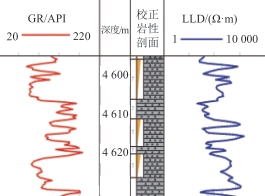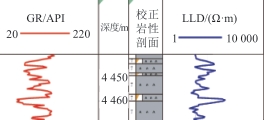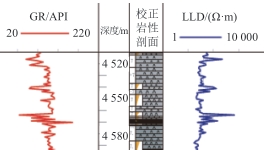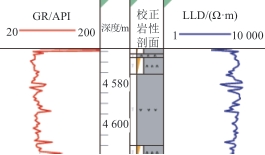

石油与天然气地质 ›› 2024, Vol. 45 ›› Issue (3): 801-815.doi: 10.11743/ogg20240316
收稿日期:2024-01-12
修回日期:2024-05-20
出版日期:2024-07-01
发布日期:2024-07-01
第一作者简介:李宁(1985—),女,副研究员,油气勘探地震地质综合研究。E‑mail: 214260630@qq.com。
基金项目:
Ning LI1,2( ), Ruilei LI2, He MIAO2, Kaifang CAO2, Jun TIAN2
), Ruilei LI2, He MIAO2, Kaifang CAO2, Jun TIAN2
Received:2024-01-12
Revised:2024-05-20
Online:2024-07-01
Published:2024-07-01
摘要:
松辽盆地深层下白垩统火石岭组中-基性火山岩广泛发育,岩性-岩相复杂,储层横向非均质性强,储层“甜点”识别难,制约了油气勘探和开发。以查干花地区为例,研究了松辽盆地深层中-基性火山岩岩相及储层特征,提出了火山通道、有利岩相、有利岩性及储层甜点识别方法。研究表明:①火山岩岩相主要为3相6亚相,优质储层岩性主要为粗粒、细粒凝灰岩和凝灰质砂岩,在近-中源相带中火山爆发相储层最为发育,相带控制了有利岩性凝灰岩的分布区域,物性和含气性是火山岩“甜点”的主要控制因素。②通过分析每个喷发期次的裂缝密度,结合蚂蚁体与地震数据的叠合剖面,识别出了不同喷发期次的火山通道,以判断火山近源相带,再结合火山机构厚度和能量半衰时属性划分中源与远源相带的边界,实现储层“甜点”发育区的定性刻画。③为降低地震反演定量预测中-基性火山岩储层的多解性,优选出低波阻抗表征沉凝灰岩,低密度表征高核磁孔隙度储层,低拉梅常数表征气层,基于此,在叠前反演密度预测孔隙度数据体的基础上,逐级剔除干扰沉凝灰岩、低孔隙度层及非气层,得到较为可靠的火山岩储层“甜点”空间分布预测结果。经验证,预测结果符合有利相带分布规律,且与已钻井气层解释结论吻合。应用有利相带定性认识及逐级定量刻画“甜点”空间分布,部署井取得较好效果,该方法可在深层火山岩“甜点”分布地震预测中广泛推广。
中图分类号:
表1
查干花地区火石岭组火山岩相测井曲线特征"
| 岩相 | 亚相 | 测井相 | 典型测井曲线特征 | 岩性特征 |
|---|---|---|---|---|
| 爆发相(水下) | 气携水下热碎屑流亚相 |  | 低GR,高LLD,曲线形态为微齿,常与水携火山密度流亚相伴生产出 | 浅灰色、灰色凝灰岩,局部含火山角砾,发育粒序层理 |
| 水携火山密度流亚相 | 中-高GR,中-高LLD,曲线形态为高幅指形,常与热碎屑流亚相互层产出 | 灰色、深灰色凝灰岩,夹薄层沉凝灰岩条带,发育层理构造 | ||
| 火山沉积相 | 含外碎屑火山沉积亚相 |  | 中-低GR,低LLD(<40 Ω·m),曲线形态为中幅指形 | 深灰色-灰黑色凝灰质砂岩、凝灰质泥岩,局部,块状构造,内部结构较均一 |
| 再搬运火山碎屑沉积 |  | 中-高GR,低LLD(<40 Ω·m)特征,曲线形态为微齿-近平滑形态,局部夹薄层爆发相 | 深灰色-灰黑色沉凝灰岩,粒度细,块状构造,内部结构较均一 | |
| 溢流相 | 上部 |  | 低GR,中LLD特征,曲线形态为低幅指化 | 气孔玄武岩、安山岩,常呈薄层产出 |
| 下部 | 低GR,中LLD特征,曲线形态为箱形 | 玄武岩、安山岩,岩性均一,与顶底围岩突变接触 |
| 1 | 李瑞磊, 杨立英, 朱建峰, 等. 松辽盆地南部断陷层火山岩储层特征及油气成藏主控因素[J]. 地学前缘, 2023, 30(4): 100-111. |
| LI Ruilei, YANG Liying, ZHU Jianfeng, et al. Volcanic reservoir characteristics and hydrocarbon accumulation control factors of rift depressions in southern Songliao Basin[J]. Earth Science Frontiers, 2023, 30(4): 100-111. | |
| 2 | 衣健, 王璞珺, 李瑞磊, 等. 松辽盆地断陷层系地震火山地层学研究: 典型火山岩地震相与地质解释模式[J]. 吉林大学学报(地球科学版), 2014, 44(3): 715-729. |
| YI Jian, WANG Pujun, LI Ruilei, et al. Seismic volcanostratigraphy of the Songliao Basin, Early Cretaceous: Typical volcanic seismic facies and geological interpretation pattern[J]. Journal of Jilin University(Earth Science Edition), 2014, 44(3): 715-729. | |
| 3 | 郭飞, 李黎, 董政, 等. 海上少井条件下低渗薄礁滩灰岩储层甜点定量解释——以珠江口盆地A油田为例[J]. 石油地球物理勘探, 2023, 58(2): 381-391. |
| GUO Fei, LI Li, DONG Zheng, et al. Quantitative interpretation of sweet spots in low-permeability limestone reservoirs in thin reef beach with few offshore wells: A case study of A oilfield in Pearl River Mouth Basin[J]. Oil Geophysical Prospecting, 2023, 58(2): 381-391. | |
| 4 | 刘玲, 王琳霖, 吴疆, 等. 鄂尔多斯盆地南部彬长区块上石盒子组7段储层识别与预测[J]. 石油与天然气地质, 2021, 42(5): 1124-1135. |
| LIU Ling, WANG Linlin, WU Jiang, et al. Reservoir identification and prediction of He 7 member in Binchang Block, southern Ordos Basin[J]. Oil & Gas Geology, 2021, 42(5): 1124-1135. | |
| 5 | 李国斌, 张亚军, 谢天峰, 等. 煤系地层致密砂岩气甜点区地震逐级预测——以鄂尔多斯盆地东南缘下二叠统山西组23亚段为例[J]. 天然气工业, 2020, 40(5): 34-42. |
| LI Guobin, ZHANG Yajun, XIE Tianfeng, et al. Seismic stepped prediction technology for tight sandstone gas sweet spot in coal measure strata: A case study of the submember 23 of the Lower Permian Shanxi Formation along the southeastern margin of the Ordos Basin[J]. Natural Gas Industry, 2020, 40(5): 34-42. | |
| 6 | 刘小平, 杨晓兰, 曾忠玉, 等. 多参数联合反演在火成岩储集体预测中的应用[J]. 石油地球物理勘探, 2007, 42(1): 44-49. |
| LIU Xiaoping, YANG Xiaolan, ZENG Zhongyu, et al. Application of multi-parameter joint inversion in prediction of igneous reservoir[J]. Oil Geophysical Prospecting, 2007, 42(1): 44-49. | |
| 7 | 郎晓玲, 韩龙, 王世瑞, 等. XB地区火山岩岩相划分及储层精细刻画[J]. 石油地球物理勘探, 2010, 45(2): 272-277. |
| LANG Xiaoling, HAN Long, WANG Shirui, et al. Lithofacies classification and reservoir delineation for volcanic rock in XB area[J]. Oil Geophysical Prospecting, 2010, 45(2): 272-277. | |
| 8 | 王玲, 张研, 戴晓峰, 等. 徐深气田徐深9井区火山岩气藏有效储层识别方法[J]. 石油地球物理勘探, 2010, 45(5): 741-747, 767. |
| WANG Ling, ZHANG Yan, DAI Xiaofeng, et al. Identification of effective volcanic gas reservoir in the block of Xushen-9 Well, Xushen Gas Field[J]. Oil Geophysical Prospecting, 2010, 45(5): 741-747, 767. | |
| 9 | 李忠诚. 火山岩储层变参数门槛值体控联合反演新方法[J]. 特种油气藏, 2015, 22(3): 55-57. |
| LI Zhongcheng. New approach of joint inversion of data volume control by threshold value of variant parameters in volcanic rock reservoir[J]. Special Oil & Gas Reservoirs, 2015, 22(3): 55-57. | |
| 10 | 仇鹏, 孔丽娜, 李道清, 等. 基于体控建模的内幕型火山岩气藏有效储层预测——以准噶尔盆地五彩湾凹陷火山岩气藏为例[J]. 天然气工业, 2017, 37(3): 48-55. |
| QIU Peng, KONG Lina, LI Daoqing, et al. Prediction of net pay zones in volcanic reservoirs with inner structures based on rock-mass controlled modeling: A case study of volcanic gas reservoirs in the Wucaiwan sag, Junggar Basin[J]. Natural Gas Industry, 2017, 37(3): 48-55. | |
| 11 | 单玄龙, 牟汉生, 刘玉虎, 等. 湖盆水下喷发火山岩相类型、特征与储集意义——以松辽盆地南部查干花地区白垩系为例[J]. 石油勘探与开发, 2023, 50(4): 719-730. |
| SHAN Xuanlong, MU Hansheng, LIU Yuhu, et al. Subaqueous volcanic eruptive facies, facies model and its reservoir significance in a continental lacustrine basin: A case from the Cretaceous in Chaganhua area of southern Songliao Basin, NE China[J]. Petroleum Exploration and Development, 2023, 50(4): 719-730. | |
| 12 | 王璞珺, 吴河勇, 庞颜明, 等. 松辽盆地火山岩相: 相序、相模式与储层物性的定量关系[J]. 吉林大学学报(地球科学版), 2006, 36(5): 805-812. |
| WANG Pujun, WU Heyong, PANG Yanming, et al. Volcanic facies of the Songliao Basin: Sequence, model and the quantitative relationship with porosity & permeability of the volcanic reservoir[J]. Journal of Jilin University(Earth Science Edition), 2006, 36(5): 805-812. | |
| 13 | 陈树民, 姜传金, 张元高, 等. 盆内火山岩反射地震响应及对油气藏分布的多尺度预测[J]. 大庆石油地质与开发, 2014, 33(5): 190-198. |
| CHEN Shumin, JIANG Chuanjin, ZHANG Yuangao, et al. Seismic response to intrabasinal volcanic rock reflection and multi-scale prediction of hydrocarbon reservoir distribution[J]. Petroleum Geology & Oilfield Development in Daqing, 2014, 33(5): 190-198. | |
| 14 | 唐华风, 边伟华, 王璞珺, 等. 盆地火山岩相分类和模式[J]. 吉林大学学报(地球科学版), 2023, 53(06): 1651-1671. |
| TANG Huafeng, BIAN Weihua, WANG Pujun, et al. Classification and model of volcanic facies in the basin. Journal of Jilin University (Earth Science Edition), 2023, 53(6): 1651-1671. | |
| 15 | 张姣, 辛朝坤, 张军勇. 火山喷发机构、期次及其控藏作用——以松辽盆地北部莺山凹陷营一段为例[J]. 石油与天然气地质, 2018, 39(2): 291-299. |
| ZHANG Jiao, XIN Chaokun, ZHANG Junyong. A study on volcanic eruption edifices and stages and their control over hydrocarbon accumulation: A case study of the first member of the Yingcheng Formation in Yingshan Sag, northern Songliao Basin[J]. Oil & Gas Geology, 2018, 39(2): 291-299. | |
| 16 | 于孝玉, 阮宝涛, 王志文, 等. 火山岩气藏火山口多信息识别技术及应用[J]. 物探化探计算技术, 2011, 33(4): 351-357. |
| YU Xiaoyu, RUAN Baotao, WANG Zhiwen, et al. Multi-information identification technique of crater and its application to volcanic gas reservoirs[J]. Computing Techniques for Geophysical and Geochemical Exploration, 2011, 33(4): 351-357. | |
| 17 | 鲁银涛, 王彬, 吕福亮, 等. 南海西北部火山岩地震属性特征及发育模式[J]. 地球物理学进展, 2014, 29(5): 2407-2410. |
| LU Yintao, WANG Bin, Fuliang LYU, et al. Seismic attributes and evolutional models of volcanic rocks in northwest part of South China Sea[J]. Progress in Geophysics, 2014, 29(5): 2407-2410. | |
| 18 | 刘学通, 周学锋, 刘传奇, 等. 中心式火山通道边界精细识别技术研究——以渤海A油田为例[J]. 地球物理学进展, 2019, 34(1): 342-346. |
| LIU Xuetong, ZHOU Xuefeng, LIU Chuanqi, et al. Accurate boundary recognition research of central volcanic conduit: An example from Bohai A oilfield[J]. Progress in Geophysics, 2019, 34(1): 342-346. | |
| 19 | 何贤英, 刘勇, 许学龙, 等. 西泉地区石炭系火山岩储层主控因素及有利储层预测[J]. 岩性油气藏, 2017, 29(3): 42-51. |
| HE Xianying, LIU Yong, XU Xuelong, et al. Controlling factors of Carboniferous volcanic reservoirs and favorable reservoir prediction in Xiquan area, Junggar Basin[J]. Lithologic Reservoirs, 2017, 29(3): 42-51. | |
| 20 | 曹磊, 蔡峰. 基于地震属性融合技术的火山通道识别研究[J]. 地球物理学进展, 2021, 36(2): 559-564. |
| CAO Lei, CAI Feng. Recognition research of volcanic conduit based on seismic attribute fusion technology[J]. Progress in Geophysics, 2021, 36(2): 559-564. | |
| 21 | 王璞珺, 迟元林, 刘万洙, 等. 松辽盆地火山岩相: 类型、特征和储层意义[J]. 吉林大学学报(地球科学版), 2003, 33(4): 449-456. |
| WANG Pujun, CHI Yuanlin, LIU Wanzhu, et al. Volcanic facies of the Songliao Basin: Classification, characteristics and reservoir significance[J]. Journal of Jilin University(Earth Science Edition), 2003, 33(4): 449-456. | |
| 22 | 舒萍, 丁日新, 曲延明, 等. 徐深气田火山岩储层岩性岩相模式[J]. 天然气工业, 2007, 27(8): 23-27. |
| SHU Ping, DING Rixin, QU Yanming, et al. Lithologic and lithofacies patterns of volcanic reservoirs in Xushen Gas Field[J]. Natural Gas Industry, 2007, 27(8): 23-27. | |
| 23 | 孙圆辉, 宋新民, 冉启全, 等. 长岭气田火山岩岩性和岩相特征及其对储集层的控制[J]. 石油勘探与开发, 2009, 36(1): 68-73. |
| SUN Yuanhui, SONG Xinmin, RAN Qiquan, et al. Lithologic and lithofacies characteristics of volcanic rock and their control over reservoirs, Changling Gasfield[J]. Petroleum Exploration and Development, 2009, 36(1): 68-73. | |
| 24 | 赵耀, 潘虹, 骆飞飞, 等. 准噶尔盆地红车断裂带石炭系火山岩储层特征及质量控制因素[J]. 石油与天然气地质, 2023, 44(5): 1129-1140. |
| ZHAO Yao, PAN Hong, LUO Feifei, et al. Characteristics and quality determinants of Carboniferous volcanic reservoirs in the Hongche fault zone, Junggar Basin[J]. Oil & Gas Geology, 2023, 44(5): 1129-1140. | |
| 25 | 曹鉴华, 姜传金, 赵福海, 等. 松辽盆地北部徐家围子断陷丰乐地区深层营城组有利火山岩储集体预测[J]. 石油与天然气地质, 2012, 33(4): 520-525. |
| CAO Jianhua, JIANG Chuanjin, ZHAO Fuhai, et al. Volcanic reservoir prediction of Yingcheng Formation in Fengle area, Xujiaweizi fault depression, northern Songliao Basin[J]. Oil & Gas Geology, 2012, 33(4): 520-525. | |
| 26 | 王岩泉, 胡大千, 蔡国刚, 等. 辽河盆地东部凹陷火山岩储层特征与主控因素[J]. 石油学报, 2013, 34(5): 896-904. |
| WANG Yanquan, HU Daqian, CAI Guogang, et al. Characteristics and controlling factors of Cenozoic volcanic reservoirs in Liaohe Basin, NE China[J]. Acta Petrolei Sinica, 2013, 34(5): 896-904. | |
| 27 | 徐敏, 梁虹, 邓绍强, 等. 四川盆地二叠系火山岩地震响应 特征及分布规律[J]. 科学技术与工程, 2019, 19(29): 27-32. |
| XU Min, LIANG Hong, DENG Shaoqiang, et al. Seismic response characteristics and distribution of Permian volcanic rocks in Sichuan basin[J]. Science Technology and Engineering, 2019, 19(29): 27-32. | |
| 28 | 唐华风, 王璞珺, 姜传金, 等. 松辽盆地白垩系营城组隐伏火山机构物理模型和地震识别[J]. 地球物理学进展, 2007, 22(2): 530-536. |
| TANG Huafeng, WANG Pujun, JIANG Chuanjin, et al. Physical model and seismic recognition of concealed volcanic edifices of Yingcheng Formation in Songliao Basin, Cretaceous, NE China[J]. Progress in Geophysics, 2007, 22(2): 530-536. | |
| 29 | 唐华风, 胡佳, 李建华, 等. 松辽盆地断陷期火山岩典型地震相的地质解译[J]. 石油地球物理勘探, 2018, 53(5): 1075-1084. |
| TANG Huafeng, HU Jia, LI Jianhua, et al. Geological significances of typical seismic facies of volcanic rocks of the rifted period in Songliao Basin, NE China[J]. Oil Geophysical Prospecting, 2018, 53(5): 1075-1084. | |
| 30 | 于宝利, 刘新利, 范素芳, 等. 火山岩相地震研究方法及应用[J]. 新疆石油地质, 2009, 30(2): 264-266. |
| YU Baoli, LIU Xinli, FAN Sufang, et al. Seismic technique and application of volcanic rock facies[J]. Xinjiang Petroleum Geology, 2009, 30(2): 264-266. | |
| 31 | 李希元, 景田, 吴昊. 火山岩的地震波场特征及其岩相的识别方法[J]. 大庆石油地质与开发, 2016, 35(2): 121-126. |
| LI Xiyuan, JING Tian, WU Hao. Identifying method of the seismic wave field characteristics and their lithofacieses for the volcanic rocks[J]. Petroleum Geology & Oilfield Development in Daqing, 2016, 35(2): 121-126. | |
| 32 | 陈骁, 何青林, 冉崎, 等. 四川盆地二叠系火山岩地震相特征及识别[J]. 天然气工业, 2019, 39(2): 28-36. |
| CHEN Xiao, HE Qinglin, RAN Qi, et al. Features and recognition for seismic facies of Permian volcanic reservoirs in the Sichuan Basin[J]. Natural Gas Industry, 2019, 39(2): 28-36. | |
| 33 | 张营革. 能量半衰时属性在浊积岩储层预测中的应用研究[J]. 石油物探, 2013, 52(6): 662-668. |
| ZHANG Yingge. The application of energy half-time attribute to turbidite reservoir prediction[J]. Geophysical Prospecting for Petroleum, 2013, 52(6): 662-668. | |
| 34 | 郭迎春, 张军华, 刘磊, 等. 能量半时地震属性的诠释与应用[J]. 地球物理学进展, 2015, 30(2): 746-751. |
| GUO Yingchun, ZHANG Junhua, LIU Lei, et al. The annotation and application of energy half-time attribute[J]. Progress in Geophysics, 2015, 30(2): 746-751. |
| [1] | 柳波, 蒙启安, 付晓飞, 林铁锋, 白云风, 田善思, 张金友, 姚瑶, 程心阳, 刘召. 松辽盆地白垩系青山口组一段页岩生、排烃组分特征及页岩油相态演化[J]. 石油与天然气地质, 2024, 45(2): 406-419. |
| [2] | 孙龙德, 王小军, 冯子辉, 邵红梅, 曾花森, 高波, 江航. 松辽盆地古龙页岩纳米孔缝形成机制与页岩油富集特征[J]. 石油与天然气地质, 2023, 44(6): 1350-1365. |
| [3] | 胡宗全, 王濡岳, 路菁, 冯动军, 刘粤蛟, 申宝剑, 刘忠宝, 王冠平, 何建华. 陆相页岩及其夹层储集特征对比与差异演化模式[J]. 石油与天然气地质, 2023, 44(6): 1393-1404. |
| [4] | 刘合, 孟思炜, 王素玲, 董康兴, 杨柳, 陶嘉平, 梁立豪. 古龙页岩力学特征与裂缝扩展机理[J]. 石油与天然气地质, 2023, 44(4): 820-828. |
| [5] | 白斌, 戴朝成, 侯秀林, 杨亮, 王瑞, 王岚, 孟思炜, 董若婧, 刘羽汐. 松辽盆地白垩系青山口组页岩层系非均质地质特征与页岩油甜点评价[J]. 石油与天然气地质, 2023, 44(4): 846-856. |
| [6] | 吕丹, 王华建, 李罡, 张江永, 付秀丽, 刘畅, 王晓梅, 朱如凯, 张水昌. 松辽盆地青山口组页岩沉积水体环境演变的古生物学证据[J]. 石油与天然气地质, 2023, 44(4): 857-868. |
| [7] | 张天舒, 朱如凯, 蔡毅, 王华建, 吕丹, 周海燕, 付秀丽, 刘畅, 崔坤宁, 张素荣, 王浡, 吴松涛, 张婧雅, 姜晓华, 冯有良, 刘合. 松辽盆地古龙凹陷白垩系青山口组页岩层序等时格架下的有机质分布规律[J]. 石油与天然气地质, 2023, 44(4): 869-886. |
| [8] | 李忠诚, 鲍志东, 魏兆胜, 张国一, 史燕青, 胡明毅, 邓庆杰. 箕状断陷湖盆初始裂陷期层序地层与沉积充填特征[J]. 石油与天然气地质, 2022, 43(3): 670-681. |
| [9] | 吴伟涛, 赵靖舟, 蒙启安, 林铁锋, 张革, 张金友, 斯尚华, 白玉彬. 松辽盆地齐家地区高台子油层致密砂岩油成藏机理[J]. 石油与天然气地质, 2021, 42(6): 1376-1388. |
| [10] | 白龙辉, 柳波, 迟亚奥, 李士超, 闻迅. 二维核磁共振技术表征页岩所含流体特征的应用——以松辽盆地青山口组富有机质页岩为例[J]. 石油与天然气地质, 2021, 42(6): 1389-1400. |
| [11] | 冯志强, 董立, 童英, 冯子辉, 张顺, 吴高奎, 任强. 蒙古-鄂霍茨克洋东段关闭对松辽盆地形成与演化的影响[J]. 石油与天然气地质, 2021, 42(2): 251-264. |
| [12] | 曾凡成, 张昌民, 李忠诚, 张国一, 张驰, 王拥军, 孙文铁, 邓庆杰. 断块型沉火山碎屑岩致密气藏有效储层控制因素及分布规律——以松辽盆地南部王府气田白垩系沙河子组为例[J]. 石油与天然气地质, 2021, 42(2): 481-493. |
| [13] | 高帅, 巩磊, 刘小波, 柳波, 高昂, 宿晓岑, 王杰, 李晶. 松辽盆地北部深层致密火山岩气藏天然裂缝分布特征及控制因素[J]. 石油与天然气地质, 2020, 41(3): 503-512. |
| [14] | 邓庆杰, 康德江, 胡明毅, 沈娇, 雷鸣. 松辽盆地三肇凹陷南部泉头组四段浅水三角洲河道储层构型特征[J]. 石油与天然气地质, 2020, 41(3): 513-524. |
| [15] | 梅啸寒, 张琴, 王雅芸, 吴欣松, 刘景彦, 赵家宏, 王武学. 松辽盆地扶新隆起带扶杨油层地层水化学特征及其与油气运聚关系[J]. 石油与天然气地质, 2020, 41(2): 328-338, 358. |
| 阅读次数 | ||||||
|
全文 |
|
|||||
|
摘要 |
|
|||||